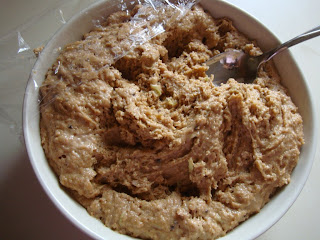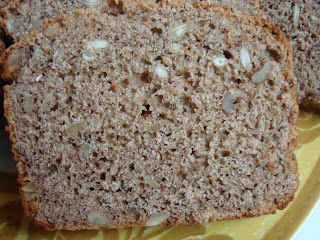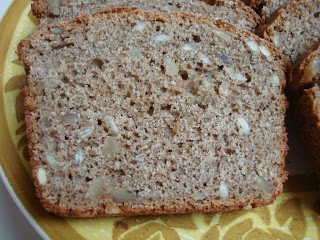My experiment with King Arthur Flour's recipe on whole wheat bread is so memorable that I definitely want to do it again. This time I don't have orange, so I use a kiwi and wonder if that will work. The kiwi in the recipe is not for the flavor, but, like the orange, for removing the bitter taste in the whole wheat flour. As it turns out, I can hardly call it a success. The loaf has a strange sour flavor that I really don't like. I also don't like it that the crumb falls apart easily. Never had such a problem with wheat breads before!
Recipe: kiwi whole wheat bread (1 medium loaf)
Ingredients:
- 3 cups King Arthur whole wheat flour
- 1 tp active dry yeast
- 1 kiwi fruit, crushed and mashed
- 2 TB brown sugar
- 1+1/4 tps kosher salt
- 1 TB vegetable oil
- about 2/3 cup warm water
- 1/2 cup walnuts
- 1/4 cup raw sunflower seeds
- addition 1/2 cup King Arthur bread flour for hydration adjustment of final dough
Procedure:
1. Proof yeast in 2 TB warm water.
2. Peel kiwi fruit and chop. Then mash it into a paste.
2. Mix flour, sugar, and salt in a medium bowl. Use fingers to break the brown sugar crumbs into fine grains.
3. Add proofed yeast and mashed kiwi fruit into the dry ingredients. Add water to hydrate. Stir to form a dough.
4. When the dough is fully mixed, add vegetable oil. Mix it well. Then allow it to rise at room temperature for about 1 hour.
5. Punch down the dough once. Chill it overnight.
6. On the next day, warm the dough on the counter top. Then punch down and add nuts.
7. Pour into a greased pan and allow to rise until volume doubles.
8. Preheat oven to 350F. Bake at 350F, middle rack, for about 40 minutes.
Results:
Day 1, 11:42am, preparing to mix the dry ingredients with proofed yeast and kiwi fruit:
Day 1, 12:02pm, dough almost done, very liquid this time:
Day 1, 12:09pm, dough ready to rise on counter top:
Day 1, 1:03pm, dough risen for 1 hour:
Day 1, 1:04pm, dough being punched down once:
Day 1, 1:06pm, dough ready to chill after being punched down:
Day 2
Day 2, 10:33am, dough warmed up for an hour, ready to mix with nuts:
Day 2, 10:34am, texture of dough:
Day 2, 10:42am, dough after mixing and punching:
Day 2, 10:55am, pan coated with shortening, lined with wax paper, then coated with shortening again:
Day 2, 11:05am, dough to rise in pan:
Day 2, 2:13pm, dough risen, but too moist to stay in shape:
Day 2, 2:38pm, dough being reworked with 1/2 cup of bread flour added:
Day 2, 2:51pm, dough taking on much better shape after re-kneading:
Day 2, 2:51pm, dough's texture after reworking:
Day 2, 2:55pm, dough to rise the second time in before baking:
Day 2, 2:56pm, dough's height before rising:
Day 2, 3:35pm, dough has risen the 2nd time:
Day 2, 3:42pm, dough ready to bake:
Day 2, 3:42pm, dough's height just before baking:
Day 2, 3:56pm, dough baked 14 minutes:
Day 2, 3:56pm, dough's crust cracked after the first 14 minutes:
Day 2, 4:45pm, loaf baked 1 hour and done, rather overcooked:
Day 2, 4:45pm, loaf's top:
Day 2, 4:45pm, loaf's bottom:
Day 2, 4:45pm, thermometer coming out clean:
Day 2, 4:46pm, loaf's height:
Day 2, 4:47pm, loaf's side:
Day 2, 4:47pm, loaf's top when just out of the oven:
Day 2, 5:51pm, loaf's top when cooled, observe the severe wrinkling:
Day 2, 6:04pm, because of the thick overcooked crust, the bread keeps falling apart when being slice. So the loaf is scrubbed of the dark overcooked sides before further slicing:
Day 2, 6:04pm, loaf being sliced after scrubbed of half the thick crust:
Day 2, 6:08pm, loaf yielding only 9 proper slices and some fragments:
Day 2, 6:08pm, end-of-loaf slice:
Day 2, 6:09pm, center-of-loaf slice:
Observations:
1. This time, I added more water than I had planned. But it may not be a bad idea. Since I am using little yeast, it may be meaningful to have a wet dough, which helps the yeast grow.
2. The texture of the dough is rather strange to me on day 2. It seems that very little gluten has developed.
3. I thought the loaf has too much water. So I let it bake for 1 hour. It turns out overcooked.
4. The texture of the loaf is very strange. It literally falls apart when I cut it. I do not understand why. I wonder if the kiwi actually hinders the gluten formation.
5. The bread has a strange sour and bitter flavor which might have come from the kiwi. I actually have noticed this flavor even in the dough right after it's formed. I thought it would go away with the baking. It doesn't.
6. It seems that when the dough has a nice flavor, the resultant loaf will turn out very nice. But if the dough does not taste right, then it's unlikely that the loaf would taste any better.
My husband continues to be encouraging and supportive in times of failure. I am most grateful for him.
Subscribe to:
Post Comments (Atom)





































No comments:
Post a Comment